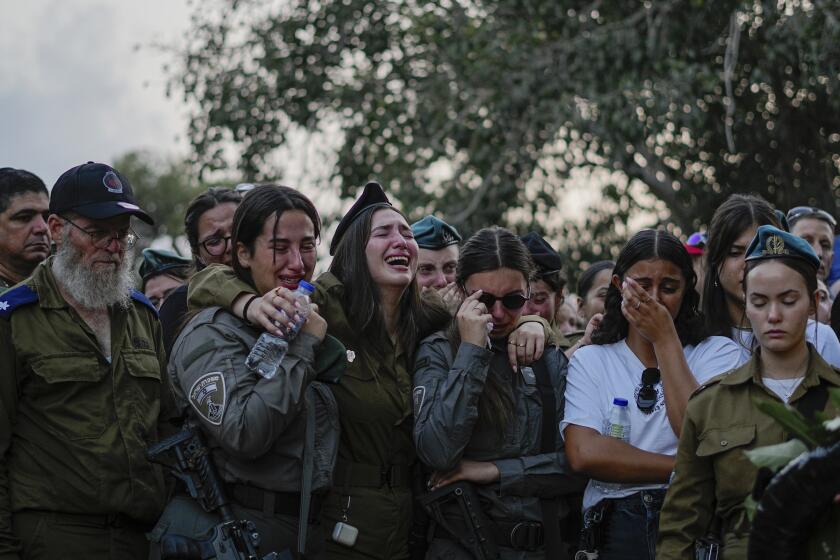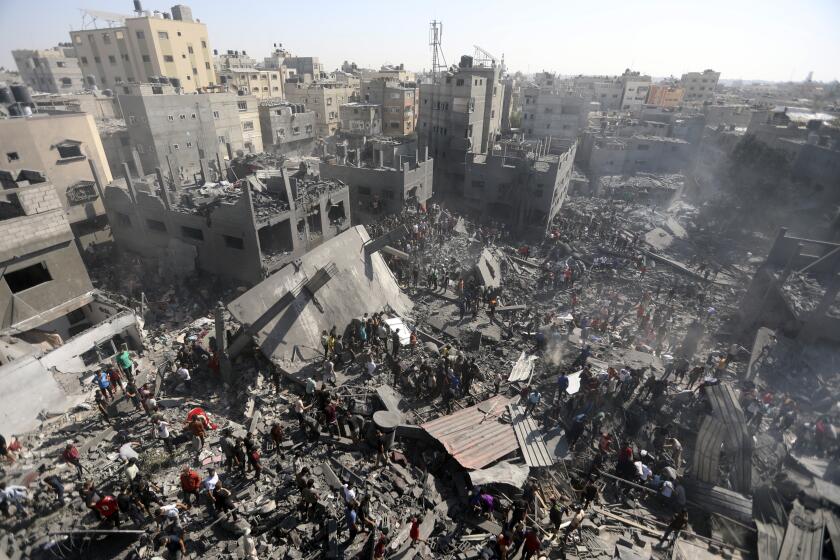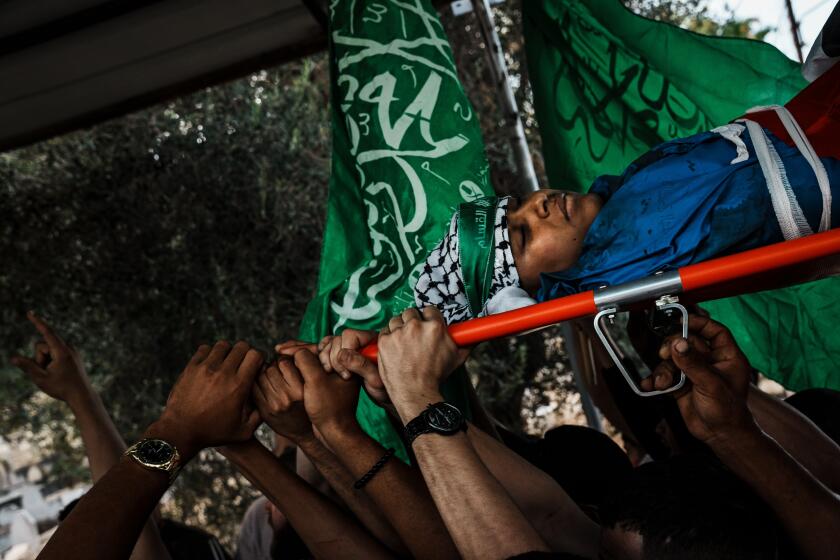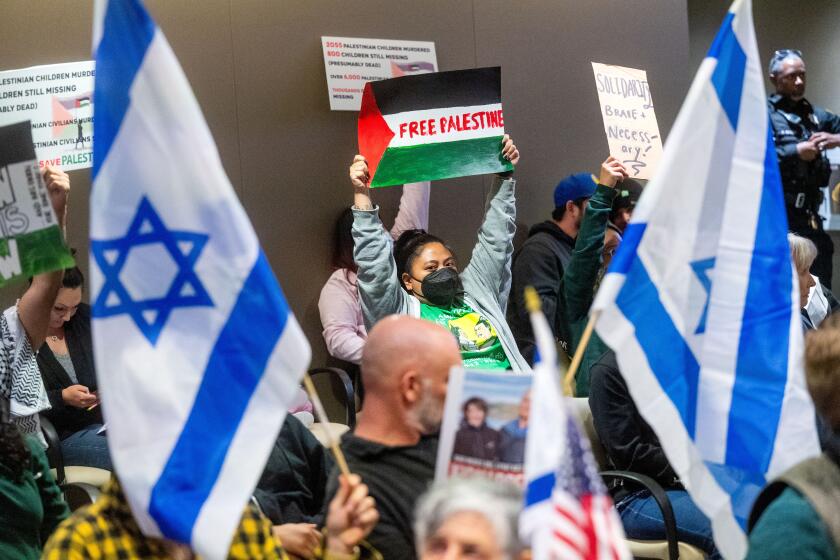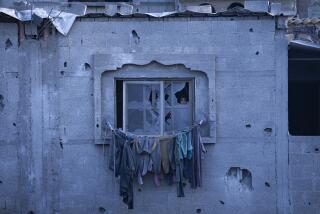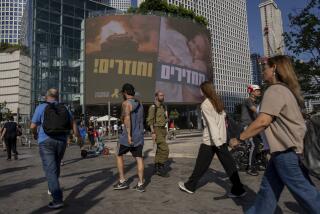‘Kidnapped from Israel,’ artists’ posters say. Some are being torn down
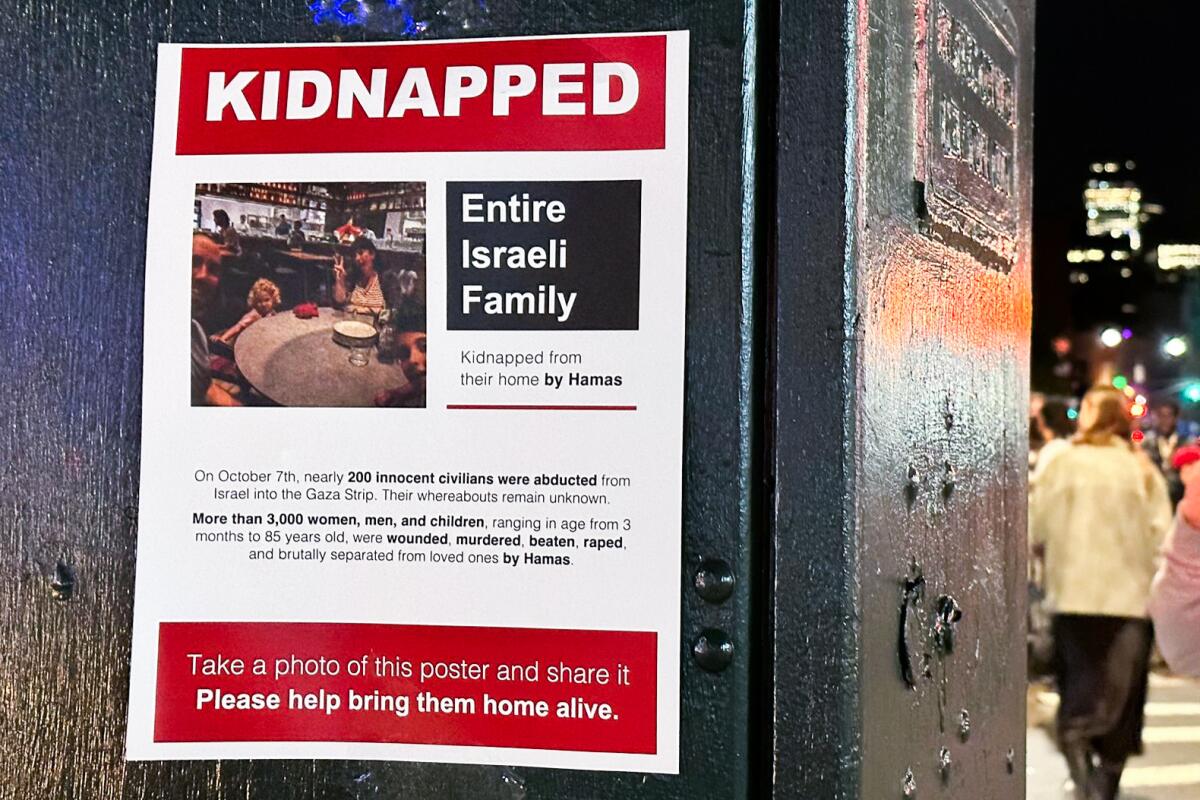
- Share via
NEW YORK — In cities around the world, the fliers plastered on street poles, lining subway stations, clinging to tree trunks and hanging in public spaces draw the eye with one word in bold on a striking red background: “Kidnapped.”
Each bearing the photo of one of more than 200 hostages taken during Hamas’ attack on Israel this month, the posters are part of a guerrilla art project designed to bring attention to those held captive and their families. They are also a reminder of how deeply polarizing the war has become as Israel continues to bomb the Gaza Strip in the weeks since Hamas’ attack — soon after they’re put up, some of the fliers are torn down.
The project, “Kidnapped from Israel,” is an idea from Nitzan Mintz and her partner, known as Dede Bandaid, two street artists from Tel Aviv who were in New York when Hamas launched its early morning incursion Oct. 7. According to the Israeli military, 222 people were abducted and about 1,400 Israeli citizens and soldiers were killed in the rampage by Hamas militants.
As news coverage revealed the scale of the assault, Bandaid and Mintz, who originally came to New York for an artists’ residency, were glued to their television and phones nearly 5,700 miles away.
“Very quickly we understood that we have to do something, that we can’t sit so far from home and just do nothing,” said Bandaid, 36. “We really wanted to put the message out there.”
Californians whose Israeli relatives are believed to be among Hamas’ hostages in the Gaza Strip are waiting, grieving and trying to hold out hope for their release.
Inspired by the pictures of missing children that appeared on the sides of milk cartons in the 1980s, the artists turned their focus to the hostages, Bandaid said. Together with Tal Huber, an Israel-based graphic designer whom they connected with on Facebook, they created red-and-black fliers emblazoned with the word “Kidnapped” in bold, capital letters across the top. Below that, the fliers show the photos, names and ages of those who were abducted, along with other details about the attack and a call to action: “Take a photo of this poster and share it. Please help bring them home alive.”
The hostages on the fliers range from infants to octogenarians. Some were snatched from their homes; others were abducted from a music festival in the Negev desert.
Within days of the attack, Mintz and Bandaid had printed about 2,000 copies of the fliers and walked across Manhattan, taping the signs to street poles and anywhere else they could.
“We just put the posters up with duct tape, crying the entire day,” said Mintz, 32.
While putting up the fliers, they said, they met some people who were unaware of the crisis, and others who didn’t want to help.
“We went home in the night devastated completely,” Mintz said.
Israel-Hamas war: In a national vigil of sorts, Israelis hope for the return of more than 220 people seized by militants and believed held in Gaza.
So they uploaded the fliers to the cloud and posted about the effort on social media, encouraging others to join. When they woke up, Mintz said, “the entire city was covered” with the posters.
The project has spread beyond New York, with fliers in 30 languages posted from Sydney, Australia, to Santiago, Chile. They have appeared at demonstrations and on the side of the United Nations building. Public areas worldwide portray the grief and anguish of families gripped with uncertainty.
But the images are especially poignant where they originated in Manhattan, bringing to mind the missing-person posters that covered the city after the Sept. 11 attacks, when families hoped their loved ones might be wandering different neighborhoods or unidentified in hospitals.
The artists’ fliers have inspired similar movements, including in Los Angeles, where a local businessman started using billboards to feature the images of young Israeli children who were abducted.
Israeli forces launched an hours-long ground raid into northern Gaza overnight, striking militant targets in advance of an expected full-on invasion.
Hamas has so far released four hostages, including two Americans. Hamas officials have said that some captives are being held in safe locations and in its network of underground tunnels, and that not all are being held by the group, which is designated as a terrorist organization in the United States.
Still, as the U.S. urges Israel to delay a ground invasion of Gaza to allow time to negotiate the release of hostages, who could be put in grave danger by urban combat, the exact whereabouts of many remains unknown. Their families have been turning in part to Mintz and her partners, particularly Huber, who is on the receiving end of many anguished phone calls.
Mintz and Bandaid said the project is humanitarian, not political — a campaign intended to bring depth and dimension to the rising number of hostages in Gaza circulating in the news media.
“There, it is only a number,” Bandaid said. “You can’t see all the real people, the real faces, all the variety of ages — from babies, toddlers, men, women, elderly people. You don’t know the personal stories of each and every person.”
Violence surges in the West Bank as Israel increases raids to root out militants. Palestinians say the military is using the war as an excuse to crack down.
But the fliers have become enmeshed in the complicated and heated emotions surrounding the conflict. After the Oct. 7 attack, Israel ordered Gaza’s borders be sealed completely and has launched a round-the-clock assault on the enclave. According to the Gaza Health Ministry, which is run by Hamas, at least 5,700 people, about half of them children, have been killed in Gaza since the start of the war. The number has not been independently verified.
Videos circulating on social media show people tearing down the kidnapped Israeli posters in New York, Boston, Miami and other cities around the U.S. and the world, in some cases losing their jobs or facing disciplinary action by their schools for doing so.
On Thursday, posters at USC were torn down, according to Jewish organizations on campus. Chabad of USC shared video on Instagram recorded by someone confronting two people who were tearing posters from a lamppost and stuffing a bag full of them into a trash can.
“The intent of the students who posted these flyers was to draw attention to the tragedy of these 200 Israeli hostages,” USC Hillel said in a statement. “We will not allow them to be erased. These are our friends and family, and we are praying for their safe return.”
“They tear it down because they feel they tear down Israel,” Bandaid said of those targeting the posters across the world.
But the artists emphasized that they are not speaking on behalf of the government and pointed out that some Israelis have taken to the streets for rallies and protests against Prime Minister Benjamin Netanyahu and his right-wing coalition.
The city of Richmond voted to support the Palestinian people in Gaza with a controversial resolution after a marathon City Council meeting.
Mintz added that when people tear down the posters, “we see it and feel it on our flesh.”
“That could have been me,” she said.
Bandaid and Mintz withdrew from their artists’ residency but have no immediate plans to return to Israel. For now, in between finding new housing and conducting media interviews, they’re focused on their fliers and the faces staring back at them.
More to Read
Sign up for Essential California
The most important California stories and recommendations in your inbox every morning.
You may occasionally receive promotional content from the Los Angeles Times.
